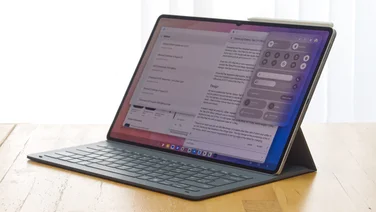To help us provide you with free impartial advice, we may earn a commission if you buy through links on our site. Learn more





Asus is one of many large technology companies from Taiwan and the country’s annual Computex conference draws big announcements from such firms. Asus didn’t disappoint this year, either, unveiling the Transformer 3 Pro, a tablet/laptop hybrid that looks suspiciously like Microsoft’s Surface Pro range. I got the chance to try it out at the Asus booth here at Computex, to see how it compares to the Surface Pro and if it really is the hybrid to replace your traditional laptop as Asus claims.
Dubbed as ‘the world’s most versatile PC’, the Transformer 3 Pro is a 2-in-1 laptop-tablet hybrid that takes many of its design features from the Surface Pro, such as a kickstand, cover keyboard and 12in metal frame. And I said ‘take’, not steal, but read that how you wish.

The Transformer 3 Pro’s integrated metal kickstand has a ‘stepless’ hinge so users can set the device at almost any angle up to 170 degrees. This works how you’d expect and seemed pretty effortlessly when I tried setting the device at different viewing angles. Asus’ Transformer Cover Keyboard is another major Surface Pro-esque feature of the Transformer 3 Pro. It boasts a backlit set of laptop-grade 1.4mm keys for a more comfortable typing experience. The chunky keys work well and have lots of travel, and the touchpad is smooth and responsive. Dare we say more so than that on the Surface Pro 4.

While its overall design is not exactly original, I have to say that the Transformer 3 Pro feels exceptionally well made and has a good strong build to it. It’s also impressively thin and light, measuring 8.35mm as its thickest point and weighing 795g (though that’s without the keyboard dock). It will also be available in four colours: Stone, Charcoal, Taupe, and Amber. Although these might not be available in all regions at launch.
The Transformer Pro 3’s 12.6in display has a resolution of 2,880×1,920, which equates to 275 pixels per inch, marginally higher than the Surface Pro 4’s 2736×1824 resolution and 267ppi. This is perhaps my favourite part on the device. Images appear pin-sharp, crisp and vibrant, which is probably thanks to the huge claimed colour gamut.
On the inside, the Transformer 3 Pro uses a relatively powerful Core i7 processor alongside a whopping 16GB of RAM for a nifty and fluid experience. This translates well in real life performance, too, as I found the transformer 3 Pro responded well to all the commands I threw at it; loading up apps and folders quickly.

In terms of storage, the Transformer 3 Pro has an impressive capacity of up to 1TB via a PCIe SSD drive, double the maximum available in Microsoft’s Surface Pro 4 model. Handy if you’re really planning on using the device for video editing and the like, but overkill for most in these days of cloud storage.
There’s a good selection of ports, starting with a USB Type-C connector supporting USB 3.1 Gen 2 devices at speeds up to 10Gbps. It comes with full-size USB 3.0 and HDMI ports as well as Thunderbolt 3 connectivity for superfast data transfers of up to 40Gbps with support for dual external 4K UHD displays. Using this it can also be connected to an external Asus XG Station 2 graphics dock, which lets you hook up the relatively small Transformer Pro 3 tablet to a full-sized desktop graphics card for PC gaming.
The laptop/tablet hybrid also has a 13MP rear-facing camera and a front-facing camera with Windows Hello facial recognition so users can log in with just a quick glance, and a microSD slot on the side for expanded storage.
Asus has given an August release date for the Transformer 3 Pro, but in my experience of previous Computex releases, I wouldn’t go holding your breath. It’s very likely it could be delayed.
Nevertheless, Asus said the Transformer 3 Pro will give the Surface Pro 4 a run for its money, with a starting price of £900 for an i5 model with 4GB of RAM, and 256GB of storage – undercutting the Surface Pro 4’s most basic model by around £70. However, like the Surface Pro, the Transformer 3 Pro gets quite pricy the more powerful you go. For instance, it will set you back £1,400 for a Core i7 model with 8GB of RAM and 512GB storage.






